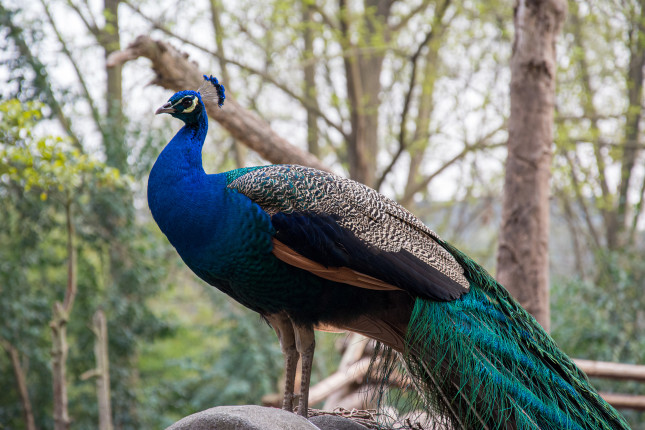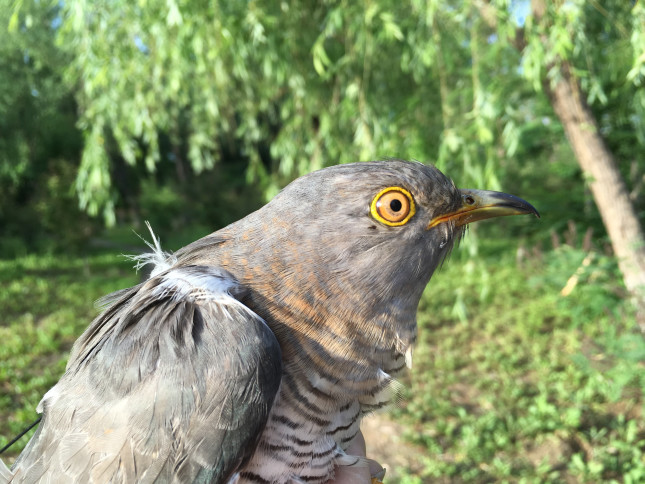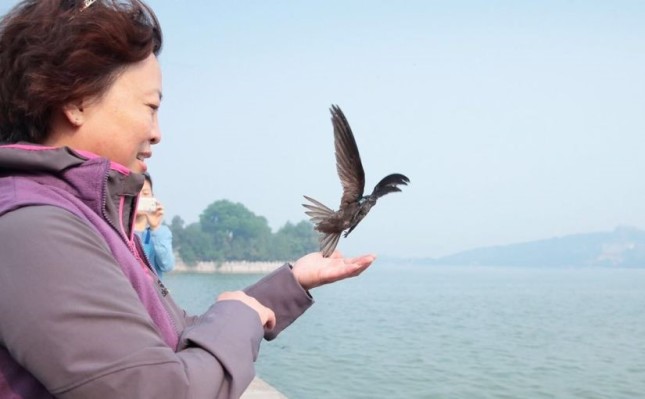-
Flying High: Q&A with Birding Beijing’s Terry Townshend
May 7, 2020 By Teresa Kennedy On March 20, the lawsuit filed by the three organizations successfully blocked the construction of the Jiasajiang I Hydropower Station in Yunnan Province, meaning that at least for now, these long-legged endangered birds are safe. This environmental victory for China’s birds builds on the designation of some of China’s Migratory Bird Sanctuaries along the coast of the Yellow Sea-Bohai Gulf as UNESCO World Heritage sites in July 2019, with more planned in the next two to three years. However, these highpoints in avian protection do not negate the fact that nearly 40 percent of China’s endemic birds are listed as threatened and require greater protection.
On March 20, the lawsuit filed by the three organizations successfully blocked the construction of the Jiasajiang I Hydropower Station in Yunnan Province, meaning that at least for now, these long-legged endangered birds are safe. This environmental victory for China’s birds builds on the designation of some of China’s Migratory Bird Sanctuaries along the coast of the Yellow Sea-Bohai Gulf as UNESCO World Heritage sites in July 2019, with more planned in the next two to three years. However, these highpoints in avian protection do not negate the fact that nearly 40 percent of China’s endemic birds are listed as threatened and require greater protection.Besides amending laws to permit citizens and NGOs to sue for habitat/species protection, the Chinese government in recent years has shown a greater commitment to protecting its country’s biodiversity. While China’s plans for hosting the United Nations Convention on Biological Diversity have been postponed to 2021 due to Covid-19, on a national level, at least two bright spots for biodiversity protection remain: the formal creation of China’s national park system, starting with the massive Sanjiangyuan area in Qinghai province, and the strengthening of China’s regulatory system for banning wildlife consumption.
National-level and citizen action to strengthen conservation are vital at a time when China’s expanding urban population is less connected to the natural environment. Birding Beijing is an online platform that provides information and initiates projects related to the capital’s wildlife. It engages in citizen science projects that inspire increased awareness of China’s wildlife including scientific breakthroughs on bird migration, improved protection of Swifts—one of the world’s fastest flying birds—and a worldwide following of Beijing’s birds.
Although Birding Beijing has been around since 2010, I discovered the platform in 2017 as a graduate student at Peking University. Many of the campus’s birds were unfamiliar to me, and when I went online to look them up, I was delighted to find a website with a comprehensive list of Beijing’s wildlife. In April 2020, I had the opportunity to chat with Terry Townshend, the platform’s founder, to discuss his decade-long experience helping to build up Beijing’s birding community and the potential of birding to encourage conservation.
Teresa: What was your reason for starting Birding Beijing?
Terry: When people found out I was a birdwatcher, everyone looked at me in astonishment and said, why are you in Beijing? Beijing has no birds. At that point, little was online about what was there. I started to explore and quickly realized that Beijing is actually a really good place for birds. We’ve now recorded over 500 different species of birds in Beijing, which is more than London, Washington D.C., Paris, Moscow, Berlin, Canberra, Ottawa…It’s probably the best major capital city in the world for bird watching.
Teresa: What makes Beijing such a great location for birding?
Terry: Beijing is good for birding for two reasons. It’s quite big with varied habitat, including mountains to the north and west, wetlands, large parks, and grassland. The main reason, though, is the geographic location. To the north, there’s a vast landmass that includes Siberia and Mongolia. This area of forests and tundra is relatively undisturbed and, due to the explosion of insects in the summer, many birds travel there to breed. However, winter there is very cold, so they migrate south, and Beijing is along their way. I describe it as sort of a service station on this superhighway for birds.
In the autumn, there’s this mass exodus from Siberia, then the return journey happens in the spring—right around now, there are millions of birds flying over Beijing. During the autumn migration, some birds stop to winter in Beijing, but others go to South China or Southeast Asia. Some go as far as Australia, New Zealand, or even Africa. These are mammoth journeys, and Beijing is a really good place to get a snapshot of this amazing migration. What struck me was how little people knew about Beijing as a capital of birdwatching, even Beijingers. One of my priorities was to raise awareness about how rich Beijing is in birds and about its importance as a stopover site for migratory birds. The more people know about Beijing as a haven for birds, the more people will care, giving greater potential to conservation efforts.
A famous Senegalese conservationist once said, “We want to protect what we love, but we can only love what we know.” If you look at global biodiversity as a whole, since 1970, the populations of vertebrates have fallen by an average of 60 percent. One in eight birds are threatened with extinction. A lot of this destruction of biodiversity happens through ignorance. There’s little you can do about exponential growth of the global population, but we can do something about raising awareness.
Teresa: Could you talk a little bit about the structure of Birding Beijing, how it works or how it’s funded?
Terry: It’s not a formal organization–rather a website and a WeChat group. Everything I do for Birding Beijing is voluntary. I use the brand to help local partners fundraise for projects like bird tracking. It’s important to work with local partners and to give them the leadership as much as possible.
Teresa: Can you tell me about one of your most successful projects and how citizen scientists have helped to protect birds?
Terry: Through our cuckoo tracking project, we have uncovered information that is new to science. Nobody before knew where cuckoos from East Asia spent the northern winter. On the very first page of the “bible” on cuckoos, the author says that cuckoos from East Asia winter in South Asia. We proved that’s wrong, which just shows how little humans know about bird migration.
This project really inspired people and engaged the public. One interesting bird we were tracking was called Flappy McFlapperson. She was a female cuckoo named by schoolchildren from the Dulwich International School in Beijing. That name really caught on, and on social media, many people were following Flappy. She went to Africa and back I think three times before we lost contact with her in Myanmar on the return one year.
I remember Former U.S. Secretary of Treasury Hank Paulson telling me that he was talking to a local professor at an airport in Chicago, and he asked him, “Have you heard about Flappy the cuckoo?” This is a professor on the other side of the world who’d never been interested in birds and was captivated by this one cuckoo. That’s what this project is all about. Conservationists are great at communicating within their own circles, but it’s also really important that we reach new circles of people, too.
Another tracking project followed Beijing Swifts. There’s a post about it on the Birding Beijing site, but in short, it was a great example of how getting kids involved led to more positive results than anticipated, with a commitment by the CEO of one of China’s biggest construction companies to better protect Swifts in the construction of his buildings. These tracking projects are very powerful, which gives me a lot of optimism.

Teresa: What kinds of benefits do birding and citizen science activities around birds offer to your average city dweller?
I think of birding as a bridge to the natural world.
Terry: I think of birding as a bridge to the natural world. We have easy access to birds, since they fly around and make noise. They are a great way of introducing people to nature. Parents mention a lot that when they were growing up, the Chinese education system had nothing about nature or biodiversity. They lacked that connection, so it’s something they really want their children to have.
Birding is something you can do anywhere, whether you live in a small village, in a remote area by the coast, or if you live in one of the world’s biggest cities. Even the middle of Beijing has tree sparrows and magpies. It’s a hobby where you never stop learning and that you can pick back up whenever you have time, on your own or in groups. It can stay with you your whole life. It’s a really flexible way of accessing nature and just feeling that connection.

Teresa: What changes have you observed in the Beijing birding community since you started Birding Beijing?
Terry: The biggest change I’ve seen is an explosion in the numbers of birdwatchers. When I first came to Beijing, I would have had better chances of seeing a bird that’s never been recorded before in Beijing than seeing another birdwatcher. Now if you go to any well-known bird watching site, you’ll encounter several birders, during the week or weekends. The number of bird watchers in Beijing is still relatively low compared with the West, but it’s expanding rapidly.
Teresa: How do you think the culture of birding could be more widely promoted within China or extended beyond birds to other kinds of animals to help with biodiversity protection?
Terry: I think it is already going beyond birds. Birds are a great introduction to nature, but I think what happens is that people get into nature through birds, then some realize they’re actually more interested in reptiles or plants or insects.
Obviously, the more people that are interested and know about the importance of nature, the more people that care, the more chance we have to protect. So it must be a good thing. If you’re interested in knowing more, be sure to check out Birding Beijing’s website and twitter account.

Teresa Kennedy is the External Relations Coordinator at Global Environmental Institute, an independent environmental non-profit, non-governmental organization and think tank based in Beijing. She is currently a Research Assistant at the Wilson Center’s China Environment Forum. Teresa holds a Master’s in China Studies from Peking University’s Yenching Academy.
Sources: AP News, BioMed Central, BirdGuides, Birding Beijing, ChinaDialogue, The Jamestown Foundation, United Nations Development Program (UNDP), The Woodrow Wilson Center, Xinhua News
Lead Photo Credit: Shutterstock.com, All Rights Reserved.
 A Publication of the Stimson Center.
A Publication of the Stimson Center.






